The 19th Century
1819
Inhabitants of the German lands attack Jews in response to Jews’ efforts to obtain civil rights. The name of the riots derives from the anti-Jewish slogan used at the time, “Hep! Hep!”
1850
The German composer Richard Wagner publishes “Das Judentum in Musik” (The Jews in Music), in which he vilifies Jewish composers, and Jews in general, for their supposed lack of a German soul.
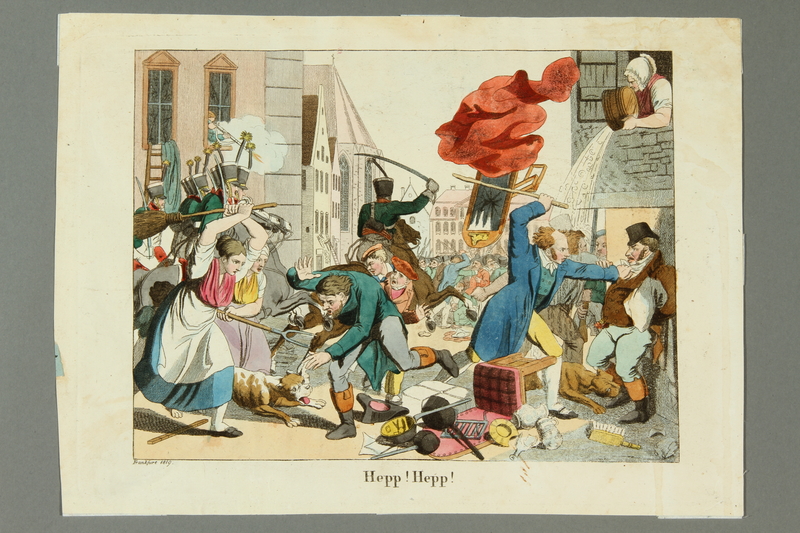
1919-1927
World War I and its Aftermath
Adolf Hitler issues his first written comment on the “Jewish Question” in which he defines Jews as a race and not members of a religion. He states that Jews are a “race-tuberculosis of the peoples” and the goal is to remove them altogether.
Manufacturing mogul Henry Ford publishes a series of antisemitic articles in The Dearborn Independent based on the a 1903 antisemitic publication from Russian written to deceive people about a Jewish conspiracy to dominate the world.
1927
The Kaiser Wilhelm Institute for Anthropology, Human Genetics, and Eugenics is founded by Prof. Eugen Fisher in Berlin. The institute stood at the forefront of promoting racial hygiene and in facilitating pseudo-scientific experiments on humans during the Nazi era.
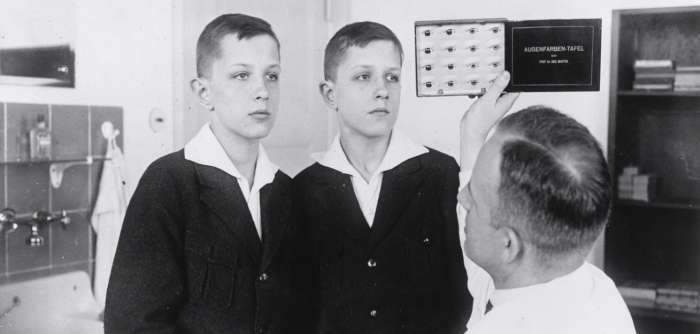
View the exhibition from USHMM: “Deadly Medicine”
1933
Adolf Hitler Rises to Power and Discriminatory Laws are Enacted
The Reichstag in Berlin is set on fire, and the Nazis claim a communist revolution is imminent.
Outside the town of Dachau, Germany, the SS establish the first concentration camp.
The Nazis organize a nationwide one-day boycott of Jewish-owned businesses in Germany.
Jews and political opponents are banned from the civil service.
Aryans who consult Jewish doctors can no longer have their medical bills paid.

On the eve of Hitler’s rise to power in 1933:
503k
Jews live in Germany
160,564
The Jewish population of Berlin
<1%
Jewish nationals comprise less than 1% of the total German population of 65 million.
60%
The rate of intermarriage had reached 60% by 1932
1933
Germany Further Targets Jewish-Owned Assets and Citizenship
Hermann Göring, Minister President and Minister of the Interior of Germany’s largest state, Prussia, creates a new agency, the Gestapo (Secret State Police).
The German government enacts the Denaturalization Law, allowing it to take away the citizenship of anyone who settled in Germany after November 9, 1918.
Books written by Jews, homosexuals, political opponents, and liberal intellectuals are burned.
The German Chambers of Literature, Press, Broadcasting, Theater, Film, Music, and Fine Arts denies membership to Jews, excluding them from employment in the cultural sector.

1934
The Media Amplifies Nazi Propaganda and Hitler Consolidates Power
The German government bans Jews from membership in the German Labor Front effectively depriving them the opportunity to find positions in the private sector and denies to those already employed the benefits available to non-Jews.
The Nazi newspaper, Der Stürmer, releases a special edition (printing and selling 130,000 copies) devoted to blood libel accusations against the Jews, including infamous medieval cartoons showing Jews using human blood in the observance of religious customs.
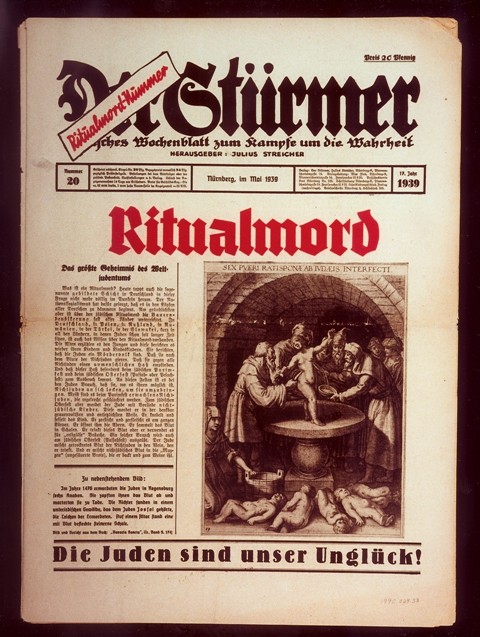
Front page of the most popular issue ever of the Nazi publication, Der Stürmer, with a reprint of a medieval depiction of a purported ritual murder committed by Jews. US Holocaust Memorial Museum, courtesy of Virginius Dabney
1935
The Nuremberg Laws are Adopted, Formalizing the Jewish Loss of Citizenship and Other Rights
At the Nazi party rally in Nuremberg, Germany adopts two laws, the “Reich Citizenship Law” and the “Law for the Protection of German Blood and Honor” (Nuremberg Laws), which officially disenfranchises and classifies Jews as non-citizens.
The first supplementary decree to the Nuremberg Laws is issued, defining a Jew as anyone with two Jewish grandparents who is married to a Jew or an adherent of Judaism, or anyone with at least three Jewish grandparents. Persons of “mixed blood” are characterized as “Mischling.”
1936-1937
Key Nazi Leaders are in Place; Additional Concentration Camps are Built
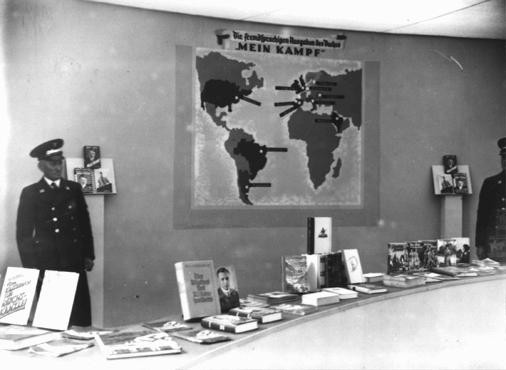
1936 Berlin Olympics
Exhibition of Nazi publications—carefully purged of antisemitic titles—on display during the Berlin Olympics. The poster shows countries in which Hitler’s Mein Kampf had been translated into the native language. Berlin, Germany, August 1936. Photo: USHMM
Hitler consolidates all German police agencies under the SS, and appoints Heinrich Himmler as Chief of the German Police and Reich Leader of the SS.
The Summer Olympic Games open in Berlin. The Olympic Games are a Nazi propaganda success. German officials remove anti-Jewish signs from public display and restrain anti-Jewish activities. The U.S. Olympic Committee bars two Jewish runners from competing. Hitler refuses to present African-American sprinter Jesse Owen his four gold medals.
Anti-Jewish riots inspired by local Nazis break out in the Free City of Danzig. Half of the city’s Jews leave within one year.
A Nazi anti- Semitic propaganda film, The Eternal Jew, begins playing throughout Germany and occupied Europe. Jews are compared to rats: carriers of disease and corrupters of the world.
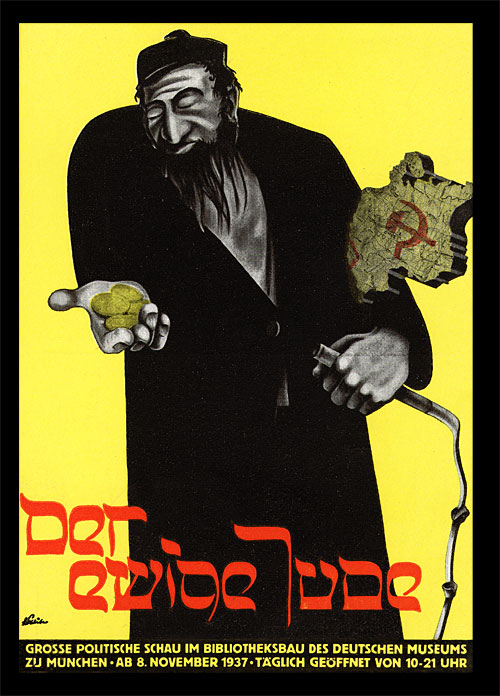
Antisemitic Propoganda
One of the most notable anti-Jewish Nazi propaganda exhibitions entitled Der ewige Jude (The Eternal Jew) attracted 412,300 visitors, more than 5,000 per day, during its run at the Deutsches Museum in Munich from November 1937 to January 1938. This image shows the cover of a 1937 publication advertising Der ewige Jude. Image: USHMM, courtesy of Julius Goldstein
1938
Hitler Annexes Austria (Anschluss); German and Austrian Jews are Required to Register their Property
German troops invade Austria and incorporate Austria into the German Reich (the Anschluss).
The “Decree Regarding Registration of Jewish Property” requires all Jews in Germany and Austria to register all assets in excess of 5,000 Reichsmarks.
SS authorities open the Flossenbürg concentration camp in northern Bavaria, Germany.
Hungary adopts comprehensive anti-Jewish laws and measures, excluding Jews from many professions.
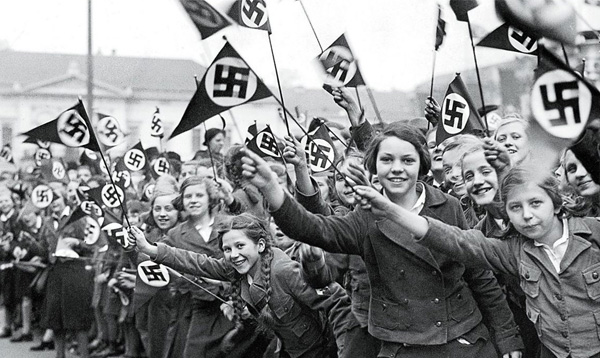
1938
Violence Against Jews Escalates While Escape Routes Close
Munich’s main synagogue is demolished on Adolf Hitler’s express orders.
The Reich Minister of the Interior decrees that all Jewish men residing in Germany must adopt the middle name “Israel.” Jewish women are required to take the middle name “Sarah.”
Adolf Eichmann, working in the Nazi Security Service (SD) and a self-styled “expert” on Jews, opens the Central Office for Jewish Emigration in Vienna.
All licenses for Jewish doctors are revoked (except those treating Jewish patients are allowed to continue).
All German passports held by Jews are invalidated by the Reich Ministry of the Interior; Jews must surrender their old passports. At the insistence of Switzerland, these passports are to be marked with a “J.”
Nearly 17,000 stateless Jews, mostly from Poland, are expelled from Germany to Poland.
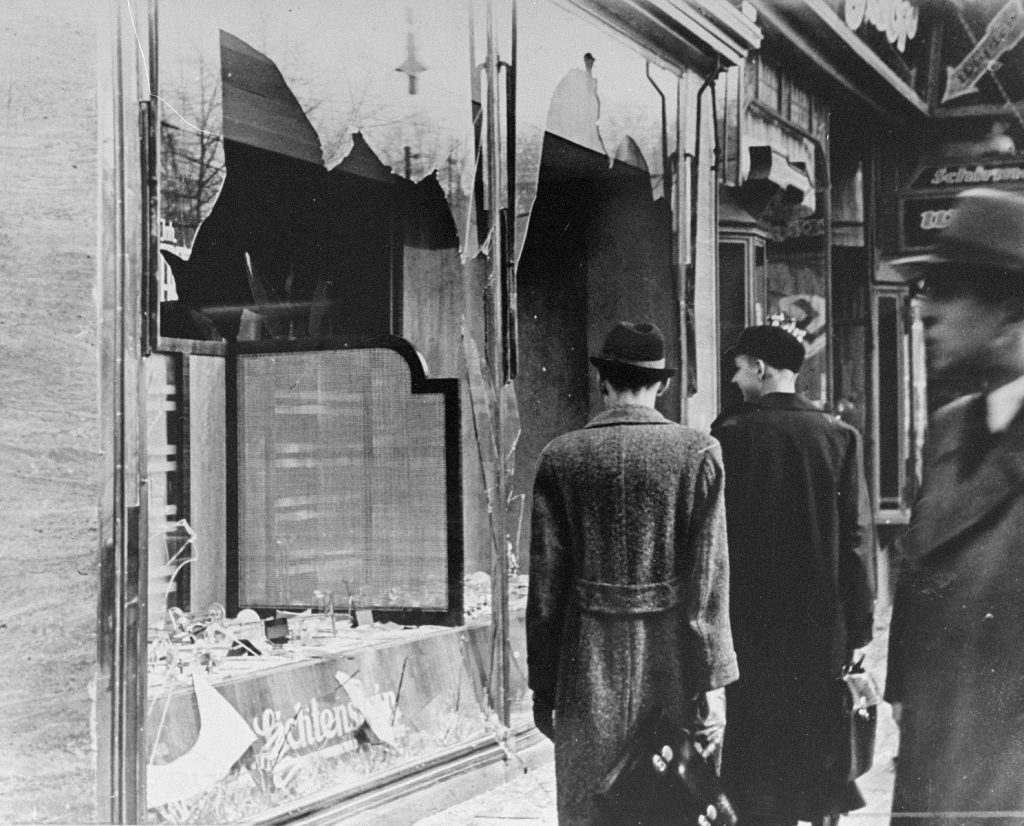
1938
Kristallnacht: The Night of Broken Glass
Kristallnacht (“Night of the Broken Glass”) riots occur in Germany and Austria. Ninety-one Jews are killed. More than 10% of Germany’s remaining Jews are arrested and sent to concentration camps. The Nazis set fire to 191 synagogues and break into and loot thousands of homes and shops.
Germany enacts a law to eliminate Jews from participation in economic life, forbidding Jews from selling goods or services, holding a trade or hosting any cultural events.
1938
Property Confiscations Escalate; Jews are Further Excluded from Public Life
German authorities ban Jewish children from German public schools.
Italy announces new racial laws defining who is a Jew, barring intermarriage between Italians and Jews, and limiting Jewish economic activity.
German authorities force Jews to sell property, businesses, and stocks to non-Jews, usually at prices far below market value.
December 1938-August 1939: The United Kingdom admits between 9,000 and 10,000 primarily Jewish children as refugees from the Greater German Reich. Through the Kindertransport, British authorities agree to permit children under the age of 17 to enter Great Britain from Germany, Austria and the annexed Czech territories.

The Kinder
transport
Jewish refugee children, part of a Children’s Transport (Kindertransport) from Germany, upon arrival in Harwich. Great Britain, December 12, 1938.
Photo USHMM
1939
Hitler Threatens to Exterminate the Jewish People; Jewish Refugees are Turned Away
Jewish businesses are forced to close under the Law Excluding Jews from Commercial Enterprises.
The German government prohibits Jews from working as nurses, veterinarians, holistic practitioners, dentists and pharmacists.
More than 900 German Jewish refugees arrive at Cuba aboard the German passenger ship SS St. Louis and are refused entry on the grounds that their entry permits are invalid. The U.S. also refuses entry, and the refugees return to Europe, where they are admitted to England, Belgium, Holland, and France.
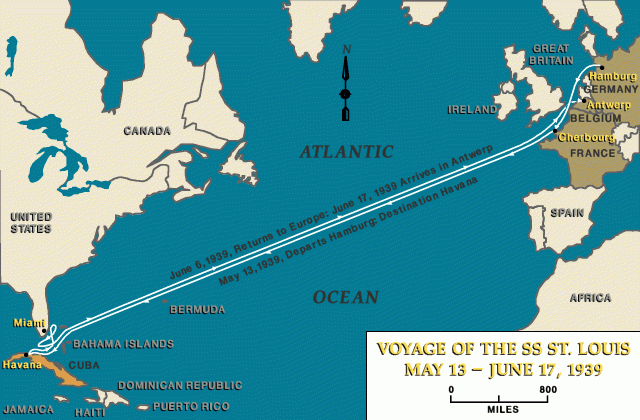
1939
The Start of World War II
Germany Invades Poland and Western Europe; Deportations Begin; the Nazis Order Jews in Poland into Ghettos
Adolf Hitler orders the first Nazi program of murder, a “euthanasia program” known as T4. German physicians are empowered to determine which mentally and physically ill persons are to be killed; ultimately some 70,000 Germans are euthanized between September 1939 and late summer 1941.
Curfews restricting Jewish individuals from going out in public after 9 p.m. in summer and 8 p.m. in winter are imposed.
Great Britain and France declare war on Germany. The British government cancels all visas that had previously been issued to German Jews.
In Nazi-occupied Poland, Jews living in the countryside are ordered into ghettos in the major cities.
The first deportations to occupied Poland from Austria and the former Czechoslovakia begin.
German authorities announced that all Jews residing in German-occupied Poland over the age of ten wear a Star of David; shortly thereafter it is expanded to all Polish Jews.
1940
The Warsaw Ghetto and the Auschwitz Concentration Camp are Created
At a Berlin conference, the Nazis decide to expel 30,000 Roma from Germany to Poland, along with Jews and Poles.
The Nazis create the Lodz ghetto. Deportations begin on February 12, 1940, with the Jews of Stettin incarcerated in Lodz.
Germany invades the Netherlands, Belgium, Luxembourg, and France. By June 22, Germany occupies all of these regions except for southern (Vichy) France.
SS authorities establish the Auschwitz concentration camp (Auschwitz I) outside the Polish city of Oswiecim, located in German- annexed Upper Silesia.
Italy enters the war as an ally of Germany. All foreign Jews in Italy are imprisoned in camps.
Auschwitz receives its first prisoners, some 700 Poles.
1940
The Warsaw ghetto is established. It is the largest ghetto in both area and population, confining more than 350,000 Jews in an area of about 1.3 square miles
Registration of Jewish property and businesses begins in occupied France and registration of Jewish businesses begins in the occupied Netherlands.

1941
The First Public Mention of the “Final Solution” and the Start of the Einsatzgruppen Mass Slaughter of Jews in the USSR
Dutch Jews are required to register themselves.
Hitler repeats his 1939 statement that he will annihilate the Jews of Europe.
Dutch citizens strike in protest against deportations of Jews from the Netherlands.
German authorities announce, establish and seal a ghetto in Krakow, Poland.
In Croatia, Jews are arrested, interned and murdered.
Jews in Romania are drafted for forced labor.
The German chemical conglomerate I.G. Farben begins construction of the Buna factory using concentration camp forced laborers from Auschwitz.
In occupied France, German authorities open the internment camp Pithiviers to incarcerate both French Jews and foreign Jews residing in France. The German authorities intern Jews in Pithiviers and other detention camps before transferring them to Drancy, from where the SS later deports them to Auschwitz and Sobibor.
1940
All Jewish Emigration is Halted; Jews are Forced to Wear a Yellow Star of David
All Jews living in German-occupied territories are prohibited from fleeing because the Nazis have decided that a “final solution” — meaning the extermination of all Jews — is coming very soon. This is the first public mention of a “final solution.”
The US State Department issues a ruling barring immigration by all persons with close relatives in Nazi-occupied Europe.
All Jewish emigration is stopped.
Jews over the age of six in the Greater German Reich must wear a yellow Star of David on their outer clothing at all times when in public.
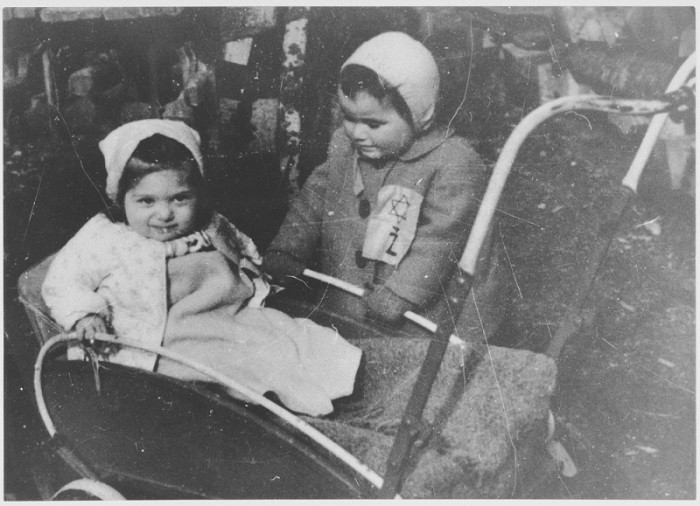
1941
The U.S. Enters World War II
The United States (along with Great Britain, Australia and New Zealand) declares war on Japan. With its entry into the war, the U.S. cancels visas previously issued to German Jews
Killing operations begin at the Chelmno (Kulmhof) killing center, located about 30 miles northwest of Lodz. The killing center operates from December 1941 until March 1943 and then briefly in June and early July 1944.
Germany declares war on the U.S.; hours later, the U.S. declares war on Germany and Italy.
The Nazis Finalize and Announce their Plans to Exterminate the Jews of Europe; First Mass Gassing of Jews at Auschwitz
1942
The Nazis Begin Deportations of Western European Jews to Killing Centers in the East; Those Not Deported are Stripped of Their Rights and Forced to Wear a Yellow Star
Nazi officials, including SS General Reinhard Heydrich as well as Adolf Eichmann, hold a conference at Wannsee, a suburb of Berlin, at which they discuss the intended murder of Europe’s 11 million Jews.
The first deportations of Western European Jews begin, from the ghettos in Lublin and Lemberg (Lviv), to the Belzec killing center.
Jews are banned from the use of public transportation. Jews of the Netherlands, Belgium and France are required to wear the yellow star.
The first mass gassing of Jews starts at Auschwitz.
Construction of an extermination camp near the village of Sobibor begins. Experimental killings of about 250 Jews takes place in the middle of April.
Nazi authorities open a second camp at Auschwitz, called Auschwitz-Birkenau or Auschwitz II. Although it serves as a concentration camp, it also functions as a killing center from March 1942 until November 1944.
1942
The Nazis Order All Jews and Roma Unfit for Slave Labor to be Exterminated
During a visit to Auschwitz, Himmler orders Jews and Roma unfit for work to be exterminated, and further orders the Birkenau camp to be expanded.
Heinrich Himmler, noting that a “total cleansing is necessary,” sends a secret directive to the head of the General Government ordering the “resettlement” (a euphemism for deportation and murder) of “the entire Jewish population of the General Government be carried out and completed by December 31.”
Twenty thousand people attend a rally at New York’s Madison Square Garden to protest Nazi atrocities. For the first time, President Roosevelt in his message to the attendees makes specific mention of atrocities against Jews and declares that the American people “will hold the perpetrators of these crimes to strict accountability in a day of reckoning which will surely come.”
1942
Jews are Deported from the Warsaw Ghetto and Elsewhere to the Killing Centers and Concentration Camps
The Germans begin deporting the Jews of Warsaw for “resettlement in the East.” In a few months, 265,000 are sent by train from the Warsaw ghetto for extermination in the gas chambers at Treblinka.
The first deportations of Belgian Jews begin, to Auschwitz.
Jews in unoccupied France are rounded up en masse.
“Asocial elements” (Jews, Roma, Russians and others) are to be transferred from the penal system to the SS, for “extermination through labor,” per agreement between Himmler and the Reich Minister of Justice.
With the assistance of collaborationist Norwegian officials, the Germans begin rounding up male Jews in Norway. The Germans eventually deport approximately 770 Norwegian Jews to killing centers and concentration camps.
1943
Jews Wage Armed Revolt Against the Nazis in the Warsaw Ghetto and in Concentration Camps; Mass Deportations to and Killings in the Death and Concentration Camps Continue (including Roma as well as the Jews of Bulgaria, Greece and Italy)
The Nazis seek to liquidate the Warsaw ghetto and are met with armed resistance; about 5,000 Jews are deported.
In Greece, German authorities order Greek Jews in Salonika to move into a ghetto, wear the yellow star and adhere to a curfew.
Bulgarian occupation authorities deport 11,343 Jews from Bulgarian-occupied countries to German custody. However, Bulgaria refuses to deport Bulgarian Jews.
On the day of the Warsaw ghetto uprising, the Allies convene an international conference in Bermuda to study the refugee question. No government expresses a willingness to accept Jewish victims of Nazism. Palestine is excluded from consideration.
Several hundred Jewish partisans revolt at Treblinka. Some 200 escape but many are recaptured and killed. In September the camp is dismantled and all traces of its existence are removed.
In his talk to SS leaders, Himmler speaks openly about the extermination of the Jews, calling it “a page of glory in our history” that “has never been written and is never to be written.”
Deportations of Jews from Italy commence. In all, more than 8,500 Italian Jews are sent to Auschwitz.
In October, the Nazis begin to dismantle the Treblinka camp, and in November complete the process, plowing the camp into the ground and planting trees to remove all traces of the killing facility.
1944
The Nazi Siege of Leningrad Ends; German Troops Occupy Hungary and Mass Deportations of Hungarian Jews Begin
German troops occupy Hungary, and anti-Jewish laws are promptly implemented.
German authorities begin to evacuate Lublin/Majdanek and deport the remaining inmates to Auschwitz, Natzweiler-Struthof, Ravensbrück, Plaszow, and Gross-Rosen.
Hungarian authorities require all Jews to wear the yellow star.
Hungarian officials, under the direction of the German SS, deport around 440,000 Jews from Hungary. Most are deported to Auschwitz, where the majority of those is murdered in gas chambers.
1944
Allied Forces Land in Normandy and Advance Toward Germany; Nazi Deportations of Jews and Roma to the Killing Centers and Concentration Camps Continue
The SS resumes deportations from the Lodz ghetto to the Chelmno killing center.
German units liquidate the Lodz ghetto and deport more than 60,000 Jews and an undetermined number of Roma (Gypsies) to Auschwitz-Birkenau.
Allied forces land in the south of France; two days later, they liberate the Drancy transit camp.
At Auschwitz- Birkenau, the Sonderkommando (special detachment of Jewish prisoners deployed to remove corpses from the gas chambers and burn them) blows up Crematorium IV and kills the guards. About 250 participants of the revolt die in battle with the SS and police units. The SS and police units shoot 200 more Sonderkommando members after the battle ends.
1944
Forced Evacuations of Jews (“Death Marches”)
With railway lines severed, Eichmann orders the evacuation of Jews from Budapest, marching them on foot toward the interior of the German Reich. These forced evacuations come to be called “death marches.”
US troops liberate the Natzweiler-Struthof concentration camp.
At Heinrich Himmler’s order, the gas chambers and crematoria at Auschwitz-Birkenau are demolished.
At Hartheim, German authorities carry out the last gassing of inmates. Under SS guard, Mauthausen prisoners dismantle the killing facility.
The Battle of the Bulge, the last major German offensive of the war, begins in the Ardennes forest.
1945
Soviet Troops Liberate Auschwitz; U.S. and British Troops Later Liberate Other Camps –
Soviet troops liberate the Auschwitz, Gross-Rosen and Ravensbrück concentration camps.
U.S. Army troops liberate the Buchenwald, Mittelbau-Dora, Bergen-Belsen, Dachau, Mathausen and Gusen concentration camps.
Hitler commits suicide in his bunker in Berlin.
The partisan resistance movement, under Communist leader Josip Tito, liberates the Jasenovac concentration camp in Croatia.
British forces liberate the Neuengamme concentration camp.
1945
World War II Ends; the Post-War Nuremberg Trials of Nazis Begin; Anti-Jewish Riots Occur in Poland
German armed forces surrender unconditionally in the West on May 7 and in the East on May 9. Allied forces proclaim May 8, 1945, to be Victory in Europe Day (V-E Day).
Soviet forces enter and liberate the camp-ghetto Theresienstadt and Stutthof concentration camps.
Credits:
This Timeline is derived primarily from the “Timeline: Selected Events Affecting Compensation for Nazi Victims,” included as a chapter in the Special Masters’ Final Report in In re Holocaust Victim Assets Litigation (Swiss Banks Settlement) (www.swissbankclaims.com). We extend our thanks to the Hon. Edward R. Korman, Special Master Judah Gribetz and Deputy Special Master Shari C. Reig, and to their assistant, Talia Magnas, who created the Timeline and have allowed us to modify it for this website.
The Claims Conference gratefully acknowledges the United States Holocaust Memorial Museum for the use of images and reference to their collections.
